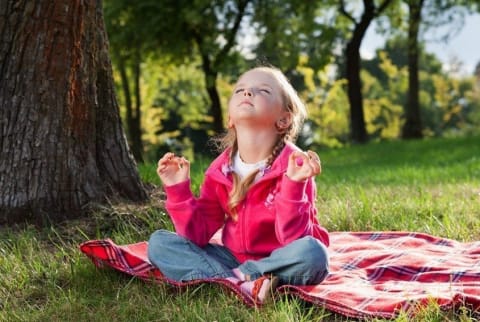Advertisement


In response to the recent lawsuit against Encinitas Union School District in California stating that yoga is religious and violates the First Amendment, I want to shed light on this debate with sensitivity and grace, clearly stating yoga in schools can be PEA-CEY!
In my experience, yoga stretches across faiths and beyond theoretical boundaries. I’m a partner for Kids’ Yoga Journey, which is a public-school friendly style of yoga that creates innovative ways to connect kids to movement, music and art through great stories and ground-breaking technology, as well as the Director of Kids’ Holy Yoga, which is an international ministry dedicated to using the time-honored practices of yoga, breathwork and meditation to share the gospel of Jesus Christ. With these different alliances at play in my own life, I know firsthand that yoga can be applied to many different scenarios with equal success.
It's possible to practice yoga in school without violating our Constitutional rights. Yoga is not a religion; it is an art, philosophy and science. The word “yoga” is derived from the root "ruj" in Sanskrit (a language of India) meaning to “unite or yoke.” Yoga is about unifying the heart, mind, soul and body into a harmonious state of wellbeing. It can be used like other common practices in religion, such as prayer, meditation and fasting.
No religion can claim yoga as its own, not even the ancient religion of Hinduism, because yoga predates Hinduism. Hinduism just happens to be the first religion to record yoga as a spiritual practice. The Hindus use yoga as a tool, along with prayer, fasting and meditation as forms of spiritual practices to unify with God. Since yoga is but one of many tools, not all Hindus choose to practice yoga. By understanding the true definition of yoga, any religion can practice yoga as a tool to “yoke and unify.”
Three ways to respect the practice of yoga and honor the public-school standards:
1. Teach yoga the same way public schools offer a moment of silence before the Pledge of Allegiance.
A moment of silence honors all faiths and beliefs without the confusion of praying to everything, anything or nothing. Yoga in the schools can be presented in the same way as a moment of silence. Teachers worldwide who teach yoga in the public schools come together to establish guidelines that help us respect different attitudes toward spirituality. To learn more about these guidelines, check out kid yoga experts at Yoga In My School, a blog radio talk show.
2. Teach with an attitude of service.
When teaching, it's important to remember it's not about “our philosophy,” it is about teaching kids the tools to quiet down the busy and overstimulated mind, ease the anxious heart and strengthen the physical body.
3. Teach the essence of yoga by demystifying the buzzwords, such as Namaste, Om, Meditation.
It's not so much about the words as it is about balance, peace of mind and a calm heart. If we can deliver the intention without the barrier of words, then we're doing our job.
Namaste is a greeting, like hello, hola or bonjour. Namaste can be a stumbling block for some, so we deliver the essence of the word without saying the “word,” with phrases such as: I see the beauty in you, I see the love in you, I see the friend in you and I see the peace in you. I respect myself and I respect you.
OM is a vibrational sound that is intended to connect a person with the self and the universe. This sound and symbol may conflict with faith traditions and is a barrier word like how the word “prayer” is in schools. The benefits of chanting OM have the same physiological effects as singing or humming. The vibration of sound is like voice therapy to the human body by stimulating the pituitary gland, which is directly linked to the endocrine system and enhancing moods. Again, the sound of “mmmmmm,” is like when we “mmmmmmm,” after a delicious meal.
A creative, school-friendly way to share this healing sound is place your hands on top of your head and HUMMMMMM away like a humming bird. Your hands will feel slight buzz or tickle, offering a great teaching opportunity to say, “When you hum, you're exercising your brain!”
As for meditation, the Mayo Clinic states, "Meditation has been practiced for thousands of years. Meditation originally was meant to help deepen understanding of the sacred and mystical forces of life. These days, meditation is commonly used for relaxation and stress reduction. Meditation is considered a type of mind-body complementary medicine.”
Even with the support of Western medicine, “meditation” can still be a barrier in the public school. Alternative words to keep the peace so that kids don’t miss out on the benefits is “quiet-time, reflection, peace-break, focus-thinking, stillness and mindfulness.”
As more and more schools embrace yoga, it's essential we check our egos, our teachings and yoga philosophy at the door. We can separate the spiritual component without compromising the inspiration and essence of yoga by weaving in universal principles like love, peace, patience, kindness, respect, honesty and health. Our pure intention encourages these seeds of peace and health to grow into lifelong skills in children’s busy, over-scheduled and inundated lives.